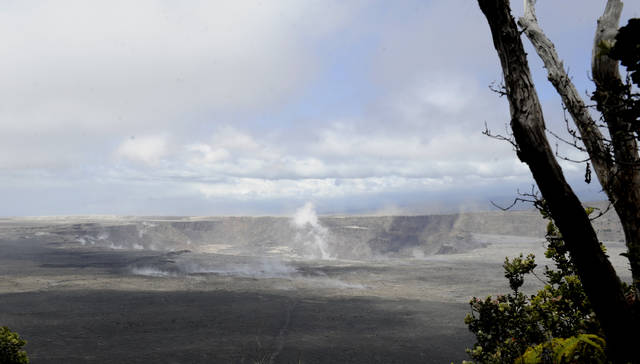Displaced USGS scientists continue to monitor Kilauea volcano

BRUCE ASATO / BASATO@STARADVERTISER.COM
Kilauea and Halemaumau Crater is seen from Waldron Ledge at Hawai’i Volcanoes National Park on June 28.
HILO >> Geologists who monitor Hawaii’s volcanoes are still among those displaced by the recent eruption of Kilauea.
The Big Island eruption began on May 3 and destroyed more than 700 homes and started a series of collapse events at the volcano’s summit.
The activity prompted a months-long closure of Hawaii Volcanoes National Park and the evacuation of scientists from the U.S. Geological Survey’s Hawaiian Volcano Observatory headquarters.
The Hawaii Tribune-Herald reported Thursday that Janet Babb, a USGS geologist and spokeswoman, says that despite having to work partially out of boxes and being spread across multiple offices in Hilo, the 29 employees continue to monitor all volcanic activity,
USGS says there have been no signs of an imminent eruption on Kilauea since surface lava activity stopped in September.
The volcano has been the home of scientists since geologist Thomas Jaggar started the first observing station on the rim of Halemaumau crater in 1912.
Don't miss out on what's happening!
Stay in touch with breaking news, as it happens, conveniently in your email inbox. It's FREE!
“I think we’re managing really well given the circumstances,” Babb said, noting observations haven’t been interrupted. “It took some pretty heroic efforts of the IT department that got things moved and set up. All the data is still flowing seamlessly.”
Babb said it’s still unclear if the geologists can return to their offices on the caldera rim or where another permanent home will be found. She said the USGS Hawaiian Volcanoes Observatory facility is badly damaged with cracked floors and walls, collapsed ceilings and offset support beams in the basement.
“We would all love to be back at that location,” she said. “Whether or not that’s going to be possible, remains to be seen.”
The National Park has said reopening the museum and overlook at that location to the public is highly unlikely. Portions of the park reopened Sept. 22.
Babb said it’s easier for geologists to be stationed at the summit to keep their eyes on the volcano, but it’s possible to monitor it remotely.
“HVO is not a building,” she said. “HVO is the heart of a place. It’s the people that make it.”
The ground continues to swell as magma refills the area that began erupting in May.
One monitoring station detected more than 10 centimeters of inflation in the past two months, which is faster than the inflation rate seen in the buildup to the May 3 eruption
Babb said that the magma is filling voids left by the eruption and a 6.9-magnitude earthquake. However, the molten rock is not showing signs of “shallowing.”
“We’re not seeing all the geophysical signals we would expect there to be prior to the outbreak of lava,” she said. “Now things are refilling and restabilizing or, of course, the (volcano) is building to the next eruption.”
“We do want to emphasize the possibility is there. It is possible the eruption is not over,” Babb added. “We’re not seeing any imminent signs of that at this time.”




